What is cap rate (capitalisation rate) and how is it helpful in property investment?
For real estate investors and developers, the cap rate is one of the most important concepts to understand. In short, the cap rate is a measure of how much cash flow a property will generate each year relative to its purchase price.
It's one of the most important calculations you can make when assessing a potential investment property. But what is it exactly? And how do you calculate it? Keep reading to find out!
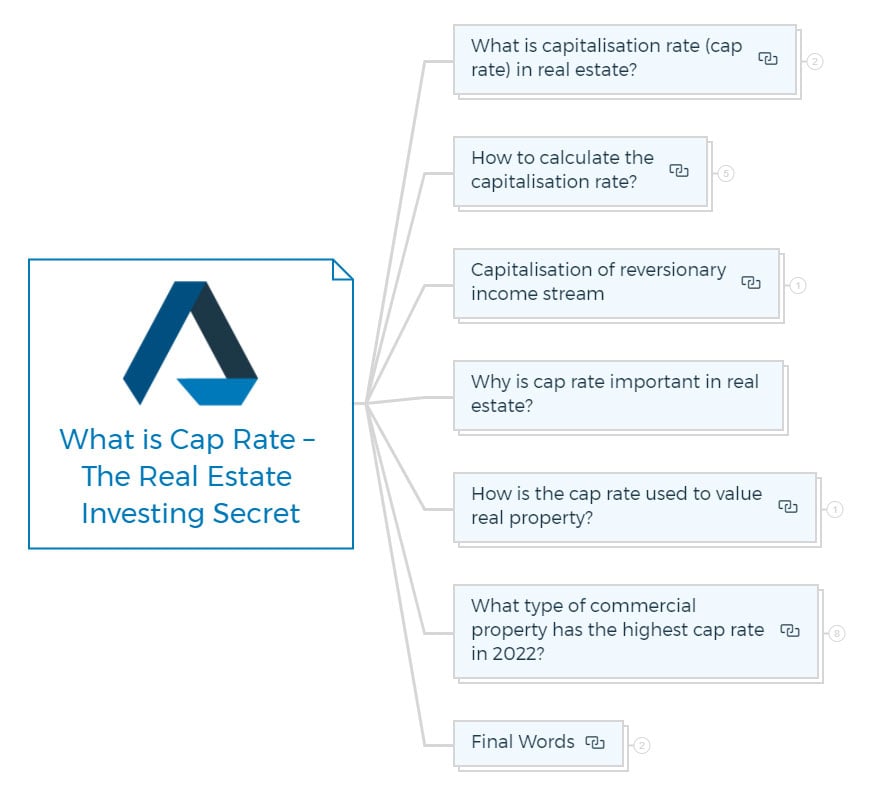
Key Takeaways
What is capitalisation rate (cap rate) in real estate?
In the simplest terms, cap rate is the rate of return on a property investment. It's calculated by dividing the income generated by a property (in the form of rent) by the purchase price of that property.
This metric is important for both investors and property managers because it provides a measure of how quickly a property is generating returns on investment. And as with any other type of investment, you want to make sure your cap rate is as high as possible.
In simple terms, the Capitalisation Rate converts rents into prices and can be expressed as
Cap Rate = Risk free rate + Risk premium
Total capitalisation rate:
An income rate for a total real estate investment that indicates the relationship between a year's expected net operating income and the total property price or value; used to transform operating revenue into overall property worth.
The terms' total cap rate' (or simply 'cap rate') and 'all risks yield' (or more simply and popularly 'yield') are interchangeable for property return rates.
The distinction between cap rate and yield is minor and has more to do with semantics than content; both terms refer to the same notion, while yield usually refers to the annual percentage return on investment.
Although the two phrases are sometimes used interchangeably, the yield is a rate of the current return (actual or predicted) resulting from a formula. While the cap rate explained above is a capitalization rate used as an input in the valuation method, i.e. the element that converts income into value.
In a metaphorical sense, they are the two halves of a coin: yield is the result of computing the current return. At the same time, the cap rate is the data used in the Direct Capitalisation Approach valuation process. Here you can learn the rocket science behind rental yield calculations.

Lower cap rates and higher Cap Rates
The capitalisation rate is inversely related to price: the lower the cap rate, the higher the price (all other things being equal).
This relationship exists because a lower cap rate means that a greater portion of the income produced by an asset is being used to service its debt, leaving less income available for distribution to equity investors.
As a result, equity investors require a higher return (in the form of a lower price) to compensate them for this decreased income.
Conversely, when cap rates are high, less income is required to service the debt on an asset, leaving more income available for distribution to equity investors.
As a result, equity investors are willing to accept a lower return (in the form of a higher price) to compensate them for this increased income.
Why are lower cap rates better?
A lower cap rate is always better than a higher cap rate from an equity investor's perspective.
A lower cap rate means that more income is available for distribution to equity investors, which results in a higher return on investment (ROI).
However, it is important to keep in mind that the relationship between cap rates and prices is not linear.
For example, a small decrease in the cap rate will result in a much larger increase in price than a large decrease in the cap rate.
It is important to understand how changes in the capitalisation rate will affect the price of a property before making any investment.
How to calculate cap rate (capitalisation rate)?
The income capitalisation rate is the most common way to estimate the value of an income-producing property. The cap rate is the net operating income (NOI) ratio to the property asset value.
You will need to know two things for cap rate calculation: the property's net operating income and purchase price (or current market value).
The formula for calculating the capitalisation rate is as follows:

For example, let's say you are considering buying a rental property for $200,000 that has a net operating income of $12,000 per year. Using the formula above, we can calculate that the capitalisation rate for this property is:
Cap Rate = $12,000 / $200,000 = 0.06, or six percent.
Q.1 A $50,000 net operating income (NOI) is generated by a property. What is the capitalisation rate if you buy it for $300,000?
Q.2 In your city, the average cap rate for small office buildings is 10%. You own a building with a $70,000 net operating income. What is a fair estimation of its worth?
Rule of Thumb
It's critical to know your market's cap rates. You can get the data through brokers, appraisers, and the internet.
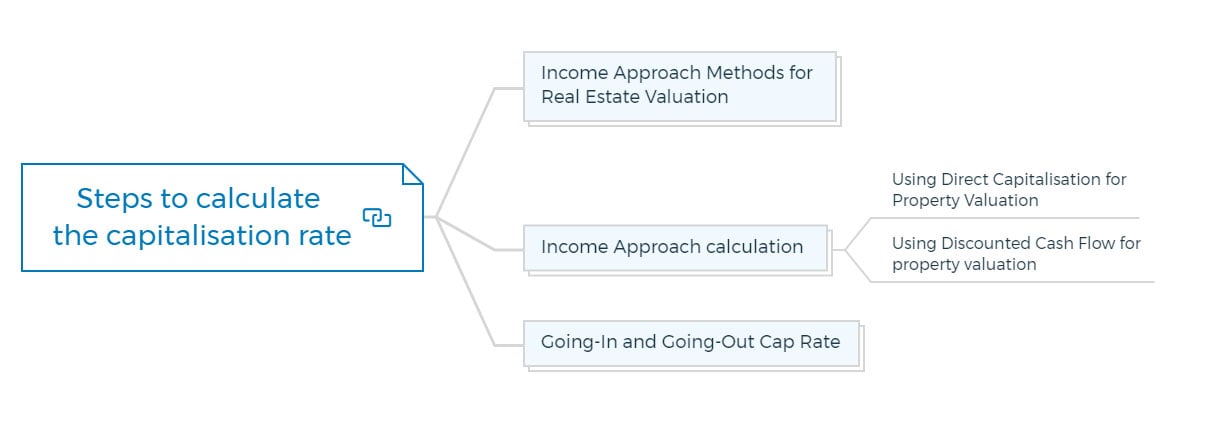
Income approach methods for real estate valuation
Because the income method assumes that a property's market value is a function of the income it is expected to generate, appraisers calculate the net income that a typical investor would expect for the subject property over the expected holding period.
The valuation estimate for the subject property will be believable as long as the appraiser correctly determines what a typical investor would expect to happen.
Common Terms used for estimating net operating income.
Potential gross income
Potential Gross Income is the estimated revenue that a company could generate in a given year. You can determine this number by multiplying the company's projected sales by its average profit margin.
Effective gross income
Effective Gross Income is the amount of money that a person makes after all deductions and expenses have been accounted for. You can use this figure to determine a person's tax liability.
Operating expenses
Operating expenses are the amount of money that a company spends each year to run its business. It includes items such as rent, employee salaries, and marketing costs.
Capital expenditures
Capital expenditure in real estate is the amount of money a company spends on acquiring, constructing, or improving real estate. It includes land, buildings, and other fixed assets.
The income approach's second step is to transform the NOI projection into a property value estimate. Income capitalisation is a term used to describe this process.
Income approach calculation
For income capitalisation, the appraiser has a variety of models and methodologies to choose from. However, there are two types of models:
- Direct capitalisation models
- Discounted cash flow models.
Using direct capitalisation for property valuation
Direct capitalisation is a valuation technique that assigns a value to a property based on the estimated future cash flows that the property is expected to generate.
You can use this value to determine the worth of the property for investment or lending purposes.
The approach of calculating a property's market worth by dividing a single-year NOI by a "capitalisation" rate is known as direct capitalisation.
The basic income capitalisation equation expresses the general connection between estimated market value and operating income:
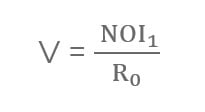
- where V denotes the current value
- NOI1 is the predicted revenue for the following 12 months
- R0 is capitalisation rate
Try yourself
Assume the subject property's expected first-year NOI is $500,000. Assume that data from comparable property sales suggests that the optimum cap rate is 10%. What is the value of the property?
Using discounted cash flow for property valuation
Aside from the heterogeneity of commercial real estate leases, the rising complexity of many deals necessitates revisions to difficult-to-quantify comparable sale prices.
The usage of DCF valuation models is frequently required for various reasons. Furthermore, investors' primary financial instrument for evaluating the advantages of commercial real estate transactions is DCF analysis.
Because appraisers are often compensated to estimate a subject property's most likely selling price, it may be advantageous to apply the valuation framework used by most investors.
The term discounted cash flow (DCF) analysis refers to the process and procedures for estimating future annual cash flows from property operations, net cash flows from property disposition at the end of the projected investment holding period and the required total rate of return.
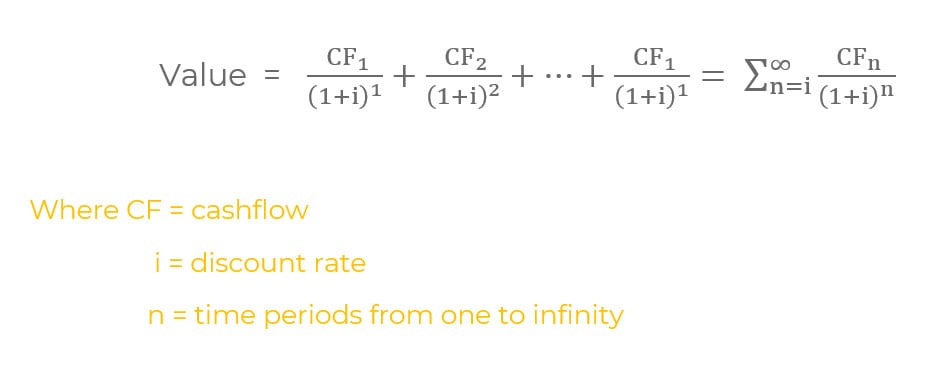
Going-in and Going-out cap rate
The Direct Capitalisation Approach can assess an asset's worth in the present, past, or future.
To value an asset, one might apply the Direct Capitalisation Approach to a given date in the present or past. The market at these dates provides information on the cap rate by extracting the yield based on income and the price of comparables.
The DCFA uses the Direct Capitalisation Approach to determine the Terminal Value.
Thus, depending on the time horizon, two definitions of cap rates are often used:
1. Going-in cap rate (GICR): the link between initial income and asset value/price at the valuation date. This is also called 'initial cap rate' or 'initial yield'.
2. Going Out Cap Rate Expected value of the asset after the valuation time (Terminal Value).
Unlike the former, you can't derive this rate from the market due to the lack of current knowledge about future transactions. It is the predicted ratio of final income to future asset value/price.
To avoid any confusion, let us state that the Going-In cap rate is commonly referred to as the cap rate and is not to be confused with the Going-Out cap rate.
The Going-In and Going-Out cap rates are the same rate examined at two different points in time: the beginning (valuation date) or when you enter or buy into a project and the end (last period in the future) or the exit date i.e. when you sell out the project or the property.
While there is only one Going-In cap rate for a single date, usually the valuation date, different Going-Out cap rates must be utilised along the time horizon depending on the date.
The Going-Out cap rate must be predicted using future market conditions. It can be estimated either by 'guessing' the future rate or by starting with the Going-In cap rate and adding/subtracting a spread based on the time risk.
The (typically positive) difference between the two rates is expressed as basis points (bps). Only a few recent research support or dispute this commonly accepted association but can pinpoint a few key drivers.
Future uncertainty is the first cause, which translates into higher GOCR risk (and, therefore, a higher rate). For the GOCR to be determined, in the absence of any refurbishment work (CapEx), a reduction in the economically usable life must be taken into account.
As a result, the building loses economic potential and requires costly structural and functional care (building renovation). The wasting asset theory, which states that all assets lose productivity over time, applies to properties. Ageing causes a decline that you can't avoid in practicality or economics.
If the residual building life is 25 years, the cap rate will be lower than if the residual building life is 5 years.
Quantifying a GOCR for use in determining the DCFA's Terminal Value remains one of its flaws. While there is no universally true answer, it is prudent to consider a few factors.
The valuation time horizon: a difference between the GICR and GOCR makes sense if the time horizon is long.
For example, if the time horizon is only a few half-years, using the same cap rate may be more appropriate if the other elements are absent.
The building's current condition, which, given the prior argument, can have a significant impact. If the building is new, a differential may not be required. If the time horizon is longer or the building is older, you must consider the consistency of maintenance expenses, CapEx predictions, and the cap rate spread.
Potential redevelopment work on the building (for example, a building that has reached the end of its life cycle) can significantly impact the GOCR. Theoretically intriguing but difficult to measure in practice, this may add to the valuer's view on the rate to be applied.
It would depend on the general fluctuation of expectations regarding market circumstances, both in terms of the risk-free rate and the additional risk premiums of property investment in general or in particular.
All of the initial assumptions are valid if no significant economic changes, changes in predicted interest rates, economic growth, or other exogenous variables affect the asset's future value.
While the GOCR may be larger than the GICR when estimating Market Value, an investor will likely seek investment opportunities where the predicted GOCR is lower than the GICR, yielding a Capital Gain Return.
Some real estate investors cautiously base their projections on GOCRs greater or equal to GICRs, covering any future losses with the larger income yield.
Increased demand for space and lower risk-free rates lead to lower future cap rates, whereas the increased supply of space and higher risk-free rates lead to higher future caps and higher property values.
Finally, the cap rate is closely tied to its historical value, and its volatility is closely linked to the performance of the market, particularly the vacancy rate.
Get The Edge Now!
Discover the transformative power of our FREE EDGE platform and
unlock a world of opportunities at no cost!
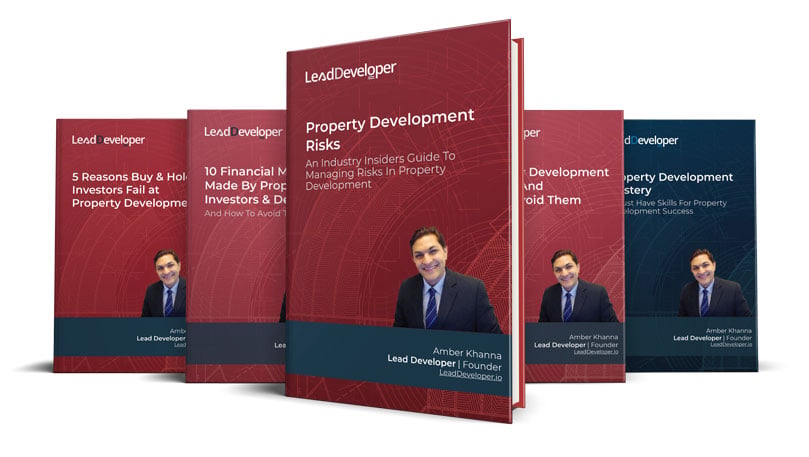
Your Real Estate Toolkit Awaits!
Free eBooks, Courses & Feasibility Suite Trial—Join Today!
✓ Unlimited FREE Trial: Experience the full power of our Feasibility Suite with hands-on demos
—explore without limits, no time pressure & without commitment or credit card!
✓ Learn from Success: Dive into real-life case studies for practical insights.
✓ Engage, Inquire, and Innovate: Ask questions, request features, and engage in lively discussions.
✓ Showcase Your Projects and Gain Insights: Share your projects and get personalised feedback.
✓ Free Resources Galore: Access a treasure trove of free resources,
eBooks & courses to keep you informed.
✓ Exclusive Training: Enjoy members-only training to sharpen your skills.
Capitalisation of reversionary income stream
In addition to valuing properties based on their current income streams, investors will often value properties based on their expected future income streams.
This is because many income-producing properties are not fully leased at the time of purchase, and the investor expects to increase the property's income by leasing up vacant space.
The capitalisation rate used to value these properties is known as the "reversionary cap rate."
Reversionary or Reversion cap rate
The reversionary cap rate is simply the capitalisation rate that an investor anticipates achieving when the property is fully leased up.
To calculate the reversionary cap rate, you will need to know three things:
- The net operating income at full occupancy.
- The purchase price (or current market value) of the property.
- The capitalisation rate that the investor anticipates achieving at full occupancy.
The formula for calculating the reversionary cap rate is as follows:

For example, let's say you are considering buying a rental property for $200,000 that has a net operating income of $12,000 per year. The property is currently 50% leased, and you expect to achieve a capitalisation rate of eight per cent when it is fully leased up.
Using the formula above, we can calculate that the reversionary cap rate for this property is:
Reversionary Cap Rate = $12,000 / $200,000 x (0.08 / 0.06) = 0.09, or nine percent.
As you can see, the reversionary cap rate is higher than the current capitalisation rate because the property is not fully leased up at the time of purchase.
A reversionary cap rate is simply a tool that investors use to estimate the value of a property based on its expected future income stream.
While it is not an exact science, it can be a useful tool for estimating the value of an income-producing property.
When valuing any income-producing property, whether for sale or lease, it's important to understand how changes in the capitalisation rate will affect the price.
Changes in the cap rate will directly impact the price of a property.

What is a good capitalisation rate?
This question does not have a simple answer as there are many factors to consider. Some people believe that a good cap rate is anything above five per cent, while others argue that it needs to be closer to ten per cent to make an investment worth your while.
If you are looking for stability and predictable cash flow, you may be more interested in properties with lower cap rates. On the other hand, if you are looking for potential appreciation and are willing to take on more risk, you may be more interested in properties with higher cap rates.
It is important to remember that capitalisation rate is just one tool you can use to evaluate an investment property. It is not the be-all and end-all when deciding whether or not to purchase a particular property.
There are many other factors to consider, such as location, condition of the property, and your personal goals and objectives.
There is no magic formula for success when it comes to real estate investing. However, by familiarising yourself with the concept of capitalisation rate and using it as one tool in your decision-making process, you will be well on your way to making smart and profitable investment choices.
Why is cap rate important in real estate?
You can use the cap rate formula for three purposes:
1. It's self-evident that you can use it to figure out a property's cap rate. Once you've determined its NOI and estimated value, you'll want to do so—most likely a seller's asking price.
In this case, you're trying to figure out whether the property has a cap rate comparable to other similar homes in the region if you buy it for the asking amount.
2. You can use the procedure to get an acceptable value estimate if you know an appropriate cap rate for this sort of property in this area. In other words, disregard the seller's asking price; what should it be worth, given the NOI and the current cap rate?
3. Finally, you can calculate the NOI by transposing it once again. When you call the listing broker, what NOI should you anticipate hearing if you know the current cap rate and the seller's asking price?
How is the cap rate used to value real property?
Suppose you are considering the purchase of an apartment building. You have determined that the current net operating income (NOI) is $100,000 per year. You also know that similar buildings in the area have recently sold for an average price of $500,000.
What is the capitalisation rate for this property?
To calculate the capitalisation rate, we will use the following cap rate formula:
Cap Rate = Net Operating Income / Purchase Price (or Market Value)
In this case, the capitalisation rate would be:
$100,000 / $500,000 = 0.20, or 20 percent.
Now let's say that you are looking at another property with an NOI of $50,000. However, this property is selling for $200,000.
What is the capitalisation rate for this second property?
$50,000 / $200,000 = 0.25, or 25 percent.
As you can see from these two examples, the capitalisation rate can vary quite a bit from one property to another.
In general, properties with higher cap rates are considered better deals because they offer more potential return on investment.

What impacts a cap rate?
A cap rate is impacted by a variety of factors, including:
- The current state of the real estate market
The capitalisation rate is also impacted by the state of the real estate market. Cap rates will be lower when the market is good, and there is high demand for properties. It is because investors are willing to pay more for a property when they know they will be able to sell it at a higher price in the future.
Conversely, cap rates will be higher when the market is slow, and there is less property demand. Investors are not as confident about their ability to sell a property for a profit in the future, so they are willing to pay less for it upfront.
- The type of property
Different types of properties also have different average cap rates. For example, properties that are considered a higher risk, such as undeveloped land or properties in need of major renovations, will generally have higher cap rates than properties considered lower risk, such as brand new buildings or well-maintained properties in desirable locations.
- The property's income and expenses
Of course, the capitalisation rate is also directly impacted by the property's income and expenses. A property with high income and low expenses will have a lower cap rate than a property with low income and high expenses.
Investors should always carefully consider all of these factors before deciding whether or not to invest in a particular property. By taking the time to do your research and understand the cap rate, you will be in a better position to make informed and profitable investment choices.
- Interest rates
When interest rates are low, the capitalisation rate will be lower. It is because investors can get a loan for the property at a lower interest rate, which means they will have to pay less interest over the life of the loan.
Conversely, the capitalisation rate will be higher when interest rates are high. It is because investors will have to pay a higher interest rate on their loan, which means they will have less money available to put towards the property's purchase price.
- The overall economy
The state of the overall economy also has an impact on capitalisation rates. When the economy is doing well, property values tend to go up, which means that investors are willing to pay more for a property and lower the cap rate.
Conversely, when the economy is struggling, property values tend to go down, which means that investors are unwilling to pay as much for a property, and the cap rate will be higher.
- The property's physical condition
The physical condition of the property is also a factor that can impact the capitalisation rate. If a property is in good condition, it will generally have a lower cap rate than a property in poor condition.
Real estate investors are willing to pay more for a property they know will not need as much money to spend on repairs and renovations.
- The location of the property
Another factor that can impact the capitalisation rate is the property's location. Properties in desirable locations, such as near good schools or in a safe neighbourhood, will generally have lower cap rates than properties in less desirable locations.
Property investors are willing to pay more for a property that is in a good location because they know that it will be easier to sell in the future.
- The current owner of the property
Finally, the property's current owner can also impact the capitalisation rate. If the current owner is motivated to sell, they may be willing to accept a lower price for the property, which will result in a higher capitalisation rate.
Conversely, if the current owner is not motivated to sell, they may be less willing to negotiate on price, which will result in a lower capitalisation rate.
Each of these factors can significantly impact the capitalisation rate of an investment property.
As a result, it is important to be aware of them before deciding whether or not to purchase a particular property.
What type of commercial property has the highest cap rate?
The type of commercial property that has the highest cap rate is industrial property. There is a high demand for industrial property and a limited supply, which drives up prices and lowers cap rates.
Other types of commercial real estate, such as office space and retail space, also have high demand but not as high as industrial property. As a result, these types of commercial real estate have lower cap rates than industrial property.
To get the best return on your investment, you should purchase an industrial property in a desirable location. It will ensure that you get a high rental income and can sell the property for a profit in the future.

What is a good cap rate on rental property?
There is no one answer to this question as it will vary depending on several factors, such as the property's location, condition, and income.
However, as a general rule of thumb, a good cap rate for rental property is usually around five to six per cent.
Key comparisons of cap rates
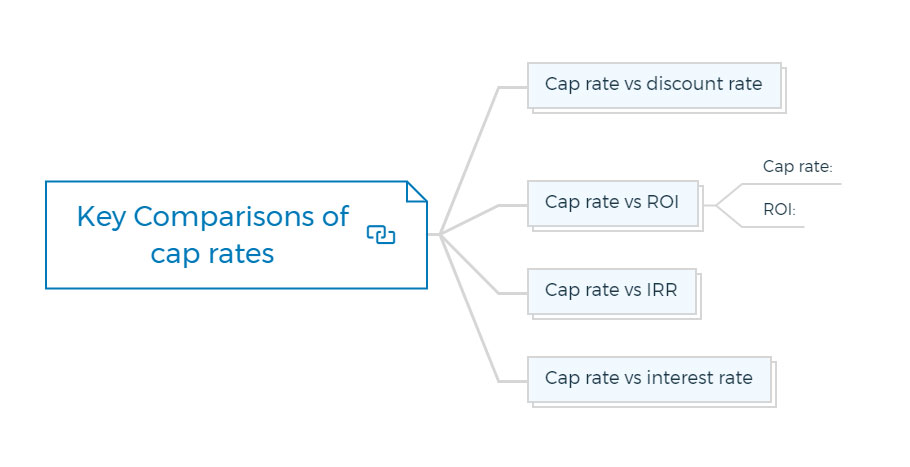
Cap rate vs discount rate
A capitalisation rate and a discount rate are two different ways of looking at the same thing – the rate of return that an investor expects to receive on an investment.
- The capitalisation rate is used when considering investments in real estate, while the discount rate is used when considering investments in stocks or bonds.
- The capitalisation rate is calculated by dividing the expected annual rent by the investment's purchase price. The discount rate is calculated by dividing the expected annual cash flow by the investment's purchase price.
- The capitalisation rate is a more conservative measure of return than the discount rate because it doesn't consider the possibility of price appreciation. On the other hand, the discount rate takes into account both the income from rent and the potential for price appreciation.
- Investors typically use a higher discount rate when considering stocks or bonds because these investments are more volatile than real estate. For example, an investor might use a discount rate of 10% when considering a stock investment but only a 5% capitalisation rate when considering an investment in a piece of property.
Cap rate vs ROI
Cap rate is the percentage of return on investment, while ROI is the actual cash return on investment. Both are important to consider when making any real estate investment, but they often mean different things to different people.
Cap rate:
- The percentage of return on investment.
- You can calculate this number by dividing the net operating income by the purchase price.
- For example, if a property costs $1 million and generates $100,000 in net operating income, the cap rate would be 10%.
ROI:
- The actual cash return on investment.
- This number is calculated by subtracting the initial investment from the sale proceeds and then dividing that number by the initial investment.
- For example, if a property is sold for $1.2 million after being purchased for $1 million, the ROI would be 20%.
As you can see, cap rate and ROI are two different ways of looking at return on investment. Cap rate is a more general measure of profitability, while ROI considers the specific details of a particular transaction. Both are important to consider when making any real estate investment.
Cap rate vs IRR
- IRR, or internal rate of return, is a measure of the profitability of an investment. It considers both the initial investment and the subsequent cash flows from the property. It makes it a good metric for comparing different investments.
- On the other hand, the cap rate measures the return on investment. It only considers the cash flows from the property and does not consider the initial investment. It makes it a good metric for assessing how well an investment performs.
Cap rate vs interest rate
The cap rate is the return on investment (ROI) that an investor can expect to receive from a property, while the interest rate is the amount of money that must be paid to borrow money.
The two are not directly related, but they are connected.
- The interest rate will affect how much an investor can afford to pay for a property.
- The cap rate will affect how much rent an investor can charge.
- The higher the interest rate, the lower the amount that an investor can afford to pay for a property.
- The lower the cap rate, the lower the amount of rent that an investor can charge.
Final words
In short, the cap rate is an important factor to consider when valuing a property. You can use it to measure an investment's attractiveness and show how much return on investment property is expected to generate.
While several factors will impact a cap rate, it is generally accepted that properties with lower risk and steadier income streams will have a lower cap rate. Those with more risk and less predictable income streams will have a higher cap rate.
If you're looking for expert advice on commercial real estate valuation or want help determining the right property development strategy, enroll for one of our structured property development courses and make your development project a success.
Test your understanding - Cap rates calculation in real estate.
You're thinking about purchasing a specific property. The seller provides you with the following information:
- For the previous 12 months, gross operating income was $153,000.
- Gross operating income forecasted for the following 12 months: $160,000
- Expenses for the previous 12 months: $50,000
You look at the source documents (lease agreements, expense records, etc.) and determine that the owner's claims are correct and reasonable.
In your area, the average cap rate for properties of this sort is 12.5 per cent. Answer the following questions using income capitalisation as your way of calculating value:
- The seller's asking price is determined by the following factors: next year's gross operating income (GOI), last year's operating expenses, and a cap rate of 12%. He adds an additional 10% for the negotiation room. How much is the asking price for it?
- What cap rate would the property yield at the full asking price if you looked at it using this year's GOI and operating expenses?
- What do you think a reasonable price for this property is?
- Why do you think the seller chose to utilise the GOI from the following year and a cap rate that is 0.5 per cent lower than the market rate?
Check the solution
1. First, you need to calculate the NOI
Net operating income = Gross operating income - operating expenses
- Gross operating income = $160,000
- Operating expenses = $50,000
- Net operating income = $110,000
Using one of the transposed variations of the cap rate formula, the seller assigns a value to the property. Remember that he chose to utilise a 12 per cent rate:
Present value = net operating income /capitalisation rate
Present value = $110,000/0.12
Present value = 916,666
He adds a 10% negotiation margin to this figure:
916,666 x 1.10 = $1,008,332
So the asking price set by the seller is = $1,008,332
2. Now you want to examine the property utilising the GOI and operating expenses from this year:
Net operating income = Gross operating income - operating expenses.
Gross Operating Income = 153,000
Operating Expenses = $50,000
Net Operating Income = $103,000
You must compute the cap rate using this NOI and the seller's asking price to answer the question; you will need the capitalisation formula:
Capitalisation rate = Net Operating Income / Present Value
Capitalisation rate = 103000/108332
Capitalisation rate = 9.50%
3. To use income capitalisation to estimate what you believe will be a fair price for the property, you must first decide on the cap rate and the NOI to employ.
It's simple to choose a cap rate. You've already determined that other properties of this type in this vicinity are selling at 12.5 per cent. There's no reason to use the 12.0% suggested by the merchant. Choose 12.5 per cent.
In this case, you've been given the GOI for the previous 12 months and the next 12 months. Which method do you use to determine the NOI?
If you're a buyer, you're probably thinking that the property's future performance isn't guaranteed and that you shouldn't be paying for it as if it were.
Furthermore, that unclear future indicates a level of risk that you are shifting from the seller's shoulders to your own. You have no intention of paying for the privilege of removing the risk from the seller's hands.
As a result, you'll be charged for what has happened, not what might happen.
To put it another way, you'll use the GOI from the previous 12 months.
Gross Operating income = $153,000
Operating Expenses = $50,000
Net Operating income = $103,000
Now find the present value
Present value = Net Operating Income/Capitalisation Rate
Present value = 103000/0.125
Present value = $825,000
Because the GOI for the following year is higher, the vendor chose to use it. Because you're capitalising the revenue to estimate the value, the bigger the income, the higher the value.
His logic is that you're buying an income stream that starts when you buy the property, so the price should reflect that.
Notice how, while he remembered to say that revenue will increase next year, he forgot to say anything about operational expenses, assuming that they would stay the same.
The decision to use a lower cap rate also raises the value estimate. Given a fixed NOI, the lower the cap rate, the higher the value.
When you compare the seller's suggested 110,000 NOI at his 12 percent to the market's 12.5 percent, you'll see the following:
Present value at 12% cap rate = 110000/0.12 = $916,666
Present value at 12.5% cap rate = 110000/0.125 = $880,000
Although a half-percentage-point difference in the cap rate may not appear to be significant, the seller is attempting to play the old salami game here.
One slice at a time, and he'll have the whole salami in no time. The seller was able to come up with an estimate of worth, before negotiation room, of $916,666, $91,000 higher than yours, by considering next year's GOI (only $7,000 more), previous year's running expenses, and a cap rate 0.5 per cent below market—all seemingly minor items.
There is, without a doubt, no alternative for conducting your own mathematics.
FAQs

